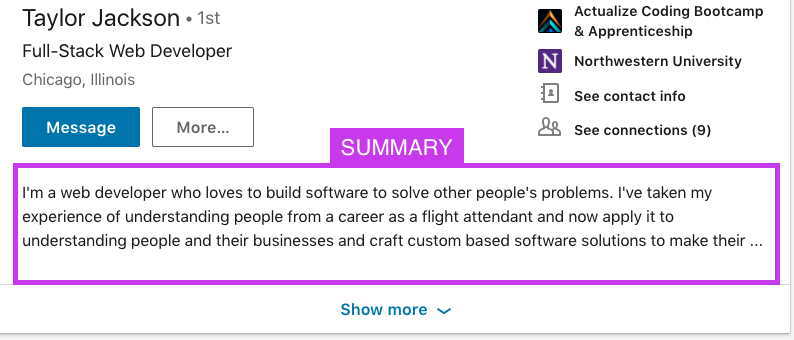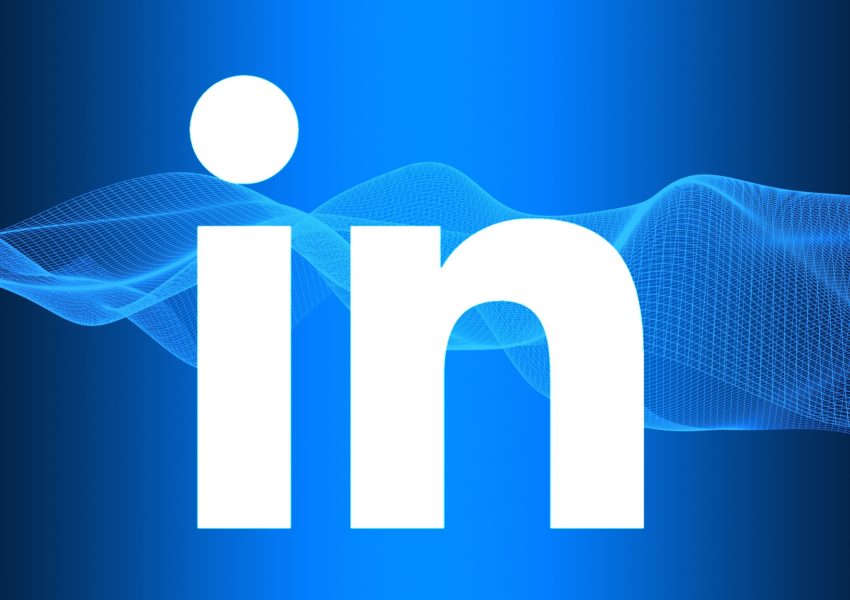Perfecting one’s LinkedIn profile is an absolute must in today’s age of job searching. Even if you don’t leverage LinkedIn directly in your job search, the hiring manager will look you up on LinkedIn at some point during the hiring process, so you may as well make it as impressive as you can. In fact, many of the Job Hacks we cover involve LinkedIn directly, as it is crucial to your ability to land a job.
In this article, we’ll talk about writing the ideal LinkedIn summary. The summary is the section bordered in purple below:

Many job seekers don’t even bother having a summary, and this is a huge mistake. The summary is extremely important, as it serves as your “elevator pitch” to prospective employers, quickly letting them know who you are, what your personality is like, and what you bring to the table.
The biggest fear all employers have is that they will hire the wrong person. In the vast majority of situations, hiring managers don’t know the job candidate personally, and they’re making a huge leap of faith based on a mere 45 minute interview and a resume. Thus, one of the foundations of job hacking is:
The more you can make hiring managers feel like they know you, the more comfortable they’ll be with hiring you.
Your LinkedIn summary is a great place to allow your personality and skills to shine through. When making my own hires, I’ve been greatly swayed in my decision by an amazing LinkedIn summary. Sometimes, a LinkedIn summary can be so compelling that I simply have to interview that individual.
While there are many formats for writing a LinkedIn summary, the format I recommend is the first-person career-story format. That is, write your LinkedIn summary in the first person, and tell the story of your career from the beginning until where you are now. This is often several paragraphs long, but this length is a good thing, because it can help your personality shine through. It’s difficult to do justice to your personality with a one-paragraph summary.
Below, I present a few LinkedIn summaries created by our grads at Actualize. For context, our grads are switching careers to software development from a (usually) entirely different career. Watch carefully how these summaries weave a good career story, and even tie in their past experience to their desired role.
Summary #1:
When I went to college, I wanted to be a storyteller. I majored in English, studying the works of Shakespeare, great graphic novelists like Art Spiegelman, and film directors like Steven Spielberg. What I realized is that as much as I loved stories, I liked analyzing them, pulling them apart, and putting them back together in better shape than they were before, more.
And so I pursued a career in book publishing, moving to New York and entering the NYU Summer Publishing Institute. But it wasn’t book publishing that I really loved, because it didn’t allow me to solve problems the same way that I had been able to in my college writing workshops.
As much as I loved storytelling, my real skill was in critiquing. In looking at the structure and flow of a piece, and pinpointing how to make it better. What I realized was that this skill, this critical eye, was applicable to other industries, other arts. It was then, that I remembered that when I had been in college, pursuing my BA in English, I had lived almost exclusively with Computer Science majors. Perhaps I had missed the boat on my destiny somewhere along the way? Perhaps a career in programming was where I could shine?
And so I pursued that new dream, teaching myself rudimentary Python, and attending the Actualize Coding Bootcamp and Apprenticeship. There, I learned both the syntax of programming (in Javascript and Ruby on Rails) as well as the philosophy of being a developer.
I am now a full-stack software developer with a love for clever solutions to problems both mundane and complex. Having worked on both projects of my own as well as leading a team of developers, I have experience in a range of development environments. My biggest asset, as predicted, has been my critical eye, picking apart code and putting it back together better than it was before.
Summary #2:
I am web developer that thrives in helping organizations solve their challenges through technology. My unique experience in the military and finance have allowed me to have a deep understanding of businesses and the people behind them. I thrive in pushing myself beyond my comfort level to learn new things.
What has led me to this unexpected point in my life? Upon graduating from high school, I wanted to be of service to something bigger than myself. In order to fulfill this strong desire, I decided to join the military as a Combat Medic. There I went above and beyond learning medical skills that were beyond what I needed. I proved myself a benefit to my fellow Marines during my two tours in Iraq where I received several awards, including a commendation from my superiors.
Upon fulfilling my service to my country, I decided it was time to enrich myself in other ways. I went to college as a veteran, which was an overwhelming experience, unable to relate to anyone at first since my journey up to that point was alien from most of my colleagues. In the spirit of service to others, while in college I started a family business. Proud to say I was able to successfully transfer the business over to my family.
Upon graduating from college with a Psychology degree I wanted to put that degree to good use and go into Finance at Barnett Capital. During my time at the company I worked in a new division, going for the challenge. In the spirit of start-ups, it allowed me to wear multiple hats leading me to increase our division’s web presence, leading me to interact with developers for the first time. At the time I was in pursuit of an M.B.A., but the love and admiration I felt for coding overtook me. Leading me to jump with both feet and pursue a career in web development, and the rest, as they say, is history.
You don’t even need to have a storied career to create a summary in this format. You can leverage any past experience and interests to create an interesting story. Here is another summary from an Actualize grad who joined us right after college:
Summary #3
My love for computers and technology really kicked off in the spring of 2014. I was in high-school, working as a host at the local restaurant near my house, and had finally saved up enough money for myself to begin purchasing computer components. By the time summer rolled around, I had a full blown desktop computer running Windows 10. I still use it to this day, whether I am researching information for new projects, working on coding practices, or just chatting with friends.
After I graduated high-school, I began pursuing an Associates in Arts degree at the local community college, with a focus in Computer Science. But after being a part of their program for about a year and a half, I discovered that it was just not the correct path for me. This was when I discovered Actualize, an amazing software development bootcamp located in downtown Chicago. Here is where I honed my skills as a software developer, learning how to build complex web-applications and the best practices for coding. My final project before graduation was an application that could find the current market price and price fluctuation of a user’s Yu-Gi-Oh cards (a trading card game).
Having graduated from Actualize, I am currently in their apprenticeship program, working on updating applications such as a Customer Relationship Management application, which allows the user to find possible applicants for the bootcamp. I am looking to help make the lives of others easier by developing apps that can assist in everyday life. My dream is to work for a company that can help me fulfill that goal through my work.
There is one more important point to factor in to your LinkedIn summary: It is important to include the job title of the role you’re seeking in your summary (and, ideally, several times within your summary). This way, recruiters will have an easier time finding you for such a role. We’ll cover the use of strategic keywords in your LinkedIn profile in a future post, but it’s important to mention it here as well.

